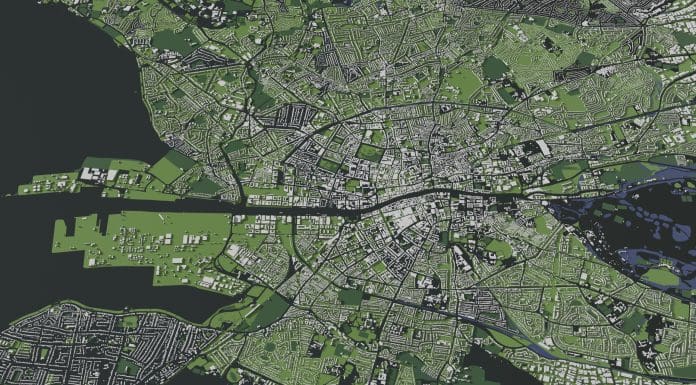
A digital twin of the Dublin Town Business Improvement District has been launched for public access to track energy consumption
The 3D Dublin Town model was commissioned by the Business Improvement District organisation, which represents over 2,000 businesses in the capital.
The model shows details of how the region consumes energy, as well as carbon emissions and where improvements can be made in the transition to net zero.
The 3D Dublin Town model combines data sources
The IES urban modelling engine, an analytics platform, live operational data and a physics-based simulation are combined and connected through an engagement portal.
The model, therefore, can track live building performance, operational carbon emissions, find the most energy-intensive areas and properties, and simulate retrofitting in buildings and iron out issues with installation or operation.
All of this is presented through live dashboards that can give early warnings when buildings are nearing inefficiency.
Richard Guiney, chief executive of Dublin Town, believes the project marks a turning point for urban regeneration. “Dublin has committed to bold carbon-reduction goals, but businesses need the clarity and confidence to act,” he said. “This model translates ambition into practical steps and empowers every operator to be able to map their pathway to lower costs and lower carbon.”
Digital twins hold potential for sustainable energy
Last month, an academic review was published, titled “Harnessing the future: Exploring digital twin applications and implications in renewable energy”, which explored the use case of digital twins in sustainable energy infrastructure, including current uses and potential future use.
It found that digital twins are currently used mostly in:
- Digital twins are effective at monitoring the condition of wind turbines, predicting damage and making recommendations to improve turbine performance.
- Analysing solar photovoltaic systems is simplified, and digital twins can be used to simulate the output of solar panels as well as detect faults.
- Hydropower systems use digital twins to forecast system behaviours and maintain a watch for structural issues within the renewable energy infrastructure.
- Digital twins are useful for modelling drilling in geothermal technologies and heat pump systems.
- In biomass technologies, digital twins can simulate boiler operations and use data to improve plant performance, boosting manufacturing.
The review also found that there is a limit to the current research, and that issues including a lack of standardised architectures and difficulty of implementation are a limit to the progressing of the technology in the sector, with the report stating: “Few studies have been published on incorporating digital twin technology throughout all stages of a physical asset’s lifecycle. To fully utilise the capabilities of digital twin technology in the future, collaboration between stakeholders and decision-makers is necessary to explore its potential in the production phase. This will allow for a comprehensive, real-time simulation of processes to meet the necessary requirements.”
The post New 3D Dublin Town model launched by IES appeared first on Planning, Building & Construction Today.

